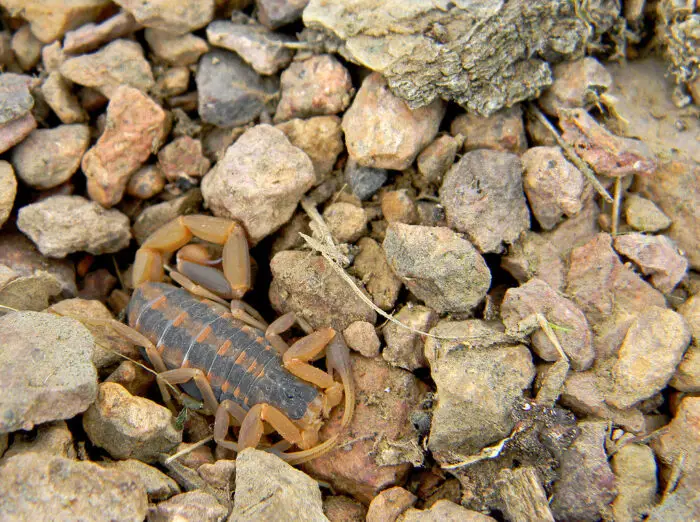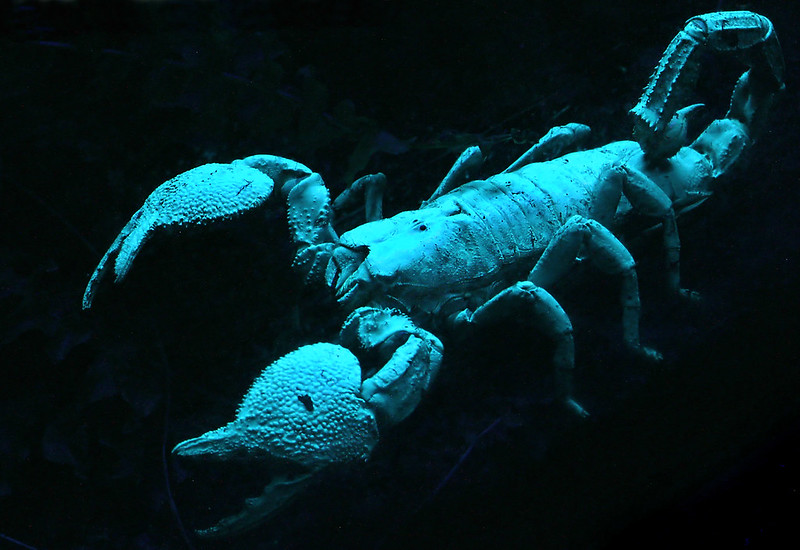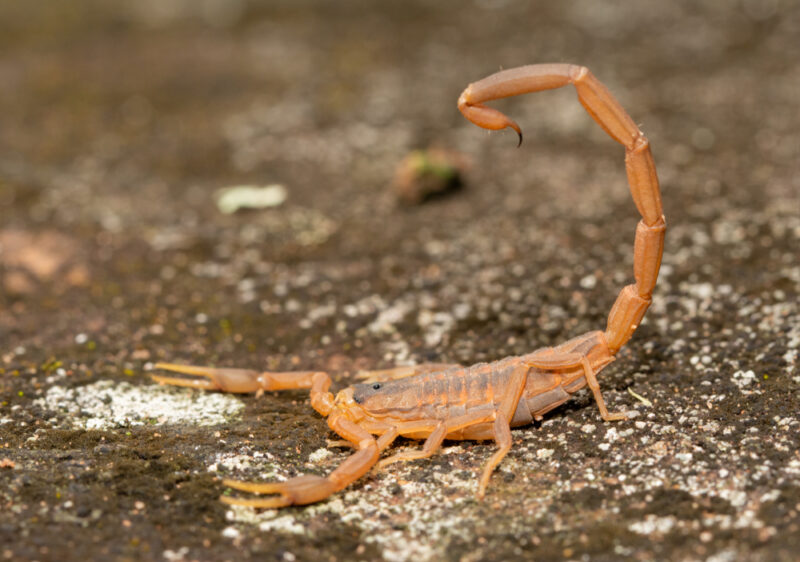What Scorpions Are Found in Oklahoma?
The Striped Bark Scorpion is the only scorpion species native to the state of Oklahoma.
Striped Bark Scorpions have stings that are no more medically significant than a wasp sting. Nevertheless, in rare cases, the sting of a scorpion has the potential to cause a severe allergic reaction. Serious symptoms such as anaphylactic shock are a possibility. If you have blurred vision, muscle twitching, severe pain, or shortness of breath after experiencing a scorpion sting, seek immediate medical attention.

Common Striped Bark Scorpion (Centruroides vittatus)
Striped Bark Scorpions, which also go by the common names Plains Scorpion, Wood Scorpion, or Stripe Backed Scorpion, are the most common species of scorpions in the continental United States. Thousands of people are stung by them each year when they step on them with bare feet or come into accidental contact with them in some other manner.
Where Do Striped Bark Scorpions Live?
Striped Bark Scorpions live in a variety of habitats in the Sooner State. In rural areas, they live in woodlands, temperate grasslands, and deserts. They are also present in such metropolitan areas as Tulsa and Oklahoma City.
During the day, they will take shelter in a variety of hiding places, such as under boards, loose stones, and loose bark, on trees or logs. They also like manmade structures such as crawl spaces, attics, wall voids, wood piles, etcetera.
The range of the Striped Back Scorpion begins in the northern Mexico states of Chihuahua, Coahuila, Nuevo Leon, and Tamaulipas. It then extends northward up to the southern counties of Nebraska. Their range also extends longitudinally from the Sangre de Cristo mountains and Rio Grande of New Mexico in the west to the Missouri River and the Mississippi River in the east. The following U.S. states have populations of Striped Bark Scorpions: Arkansas, Colorado, Kansas, Illinois, Louisiana, Mississippi, Missouri, Nebraska, New Mexico, Oklahoma, Florida, Georgia, and Texas.
In areas with colder wintertime temperatures, Striped Bark Scorpions survive by tolerating limited freezing of their body tissue. These scorpions then hibernate through the months of cold weather in clusters of multiple scorpions.

What do Striped Bark Scorpions look like?
All scorpions look a little bit like tiny land-dwelling lobsters with two proportionately large pincers and a segmented tail. There are some distinctions, though. Lobsters have 5 pairs of legs, while scorpions have 4 pairs. Of course, lobsters don’t have a bulbous venom-filled stinger on the end of their tail, while scorpions do.
Adult Striped Bark Scorpions are up to 2 3/4 inches (6.98cm) long. An adult of this species is uniformly pale yellow in color, with the exception of two longitudinal dark stripes that run the length of its back and a dark triangle at the top of the head. Bark scorpions have the ability to turn their tail to the side to lie flat, which allows them to fit into small cracks.
Striped Bark Scorpion Behavior
Unlike Northern Scorpions and Northern Black Hairy Scorpions, which never venture far from their burrows, Striped Bark Scorpions are wandering nocturnal hunters. Like all bark scorpions, they are natural climbers. Besides living under rocks, they climb trees and fence posts and have no problem climbing the walls of your home in search of prey. They actually have a negative geotaxis, or in other words, they prefer an upside-down orientation. See
How dangerous are Striped Bark Scorpions?
According to the book, “The Biology of Scorpions” by Gary A. Polis, there are over 1,500 species of scorpions in the world. Of these, fewer than 25 have stings that are lethal to humans. What’s more, all of the deadliest scorpions are members of the Buthidae family. For example, in North America, we have the Arizona Bark Scorpion. This buthid scorpion lives in the southwestern United States and northern Mexico and is on the list of deadliest scorpions.
Striped Bark Scorpions are also members of the Buthidae family. However, even though they pack a painful sting, it is not nearly as dangerous as that of their close relatives. Instead, it is more on par with the seriousness of the sting of a honeybee. It’s important to remember, though, that despite the fact that the Striped Bark Scorpion’s sting is fairly innocuous to most people, in certain individuals, it can produce serious reactions.
In fact, in 2014, a Kansas teenager from Haysville who had been playing frisbee golf, ended up spending 3 days in intensive care after being stung by what was most likely a striped bark scorpion that had been hiding in his shoe. See
Treatment for scorpion stings includes the following.
- Clean the sting site with mild soap and water.
- Apply a cold pack to the affected area.
- Avoid eating or drinking if you are having trouble swallowing.
- Treat with an over-the-counter pain reliever as needed.
- Make sure that the affected individual’s Tetanus vaccination is up to date.
- If any of the severe symptoms described in the above paragraphs are manifest, seek immediate medical attention. See
Striped Bark Scorpion Life Cycle
The mating behavior of most scorpion species is quite similar, so this section will suffice for the striped bark scorpion.
Scorpions mate in the fall and also occasionally in spring or early summer. The mating process begins with the male engaging the female scorpion in an elaborate mating dance called the promenade a deux. At this time, the male maneuvers the female to a spot where he can deposit a sperm packet called a spermatophore for her reception.
The male must hold the female over the spermatophore long enough for her to receive it. Therefore, larger males successfully mate a larger percentage of the time. If the female accepts the male’s spermatophore, the pair join together and rub chelicera in the “kiss” stage. At this point, the female takes up the spermatophore. From there, things become dicey for a large percentage of males. The male must figure out how to disengage and escape from the larger female. Once again, according to the book The Biology of Scorpions, in around 39% of scorpion species, post-mating cannibalism occurs.
What follows is about an 8-month gestation, after which their offspring are born alive.
After the newborn scorpions free themselves from the birth membrane, they will climb up their mother’s walking legs and onto her back. The female scorpions carry their young on their backs. The young scorpions ride there on their mother’s back in a grouped formation, only climbing down to feed on pellets that the female scorpions create for them when she feeds until they are sufficiently old to strike out on their own. This is generally after their first molt. See

How to look for Scorpions
As stated above, scorpions are nocturnal creatures. During the day, they hide out. Crawl spaces, wood stacks, rocky hillsides, and leaf-covered areas are all examples of likely hiding spots.
The best way to detect the presence of scorpions, though, is to search for them after dark.
Scorpions have compounds in their exoskeletons that glow under black light. To see them after dark, in your yard, or if you are camping in an area where scorpions are active, the best way to find them is with a UV flashlight. Use the ultraviolet light to scan your yard or campsite after dark. The scorpions will glow a bright blueish color.
Remember that the darker the night, the more the scorpion will glow. In other words, they are more luminous on a night of a new moon, for example. What’s more, campfires and other sources of light will cut down on the effectiveness of your ultraviolet light source.
One last thing to remember on this subject is that UV light radiating in the 320 to 400 nm range isn’t overly harmful to your vision. However, if you choose to use a UV light source that produces shorter wavelengths, you’ll want to also use eye protection.
Fun Fact
Even fossilized scorpions glow under ultraviolet light.
You may also like:
Recent Posts
The only venomous snakes in Washington State are Northern Pacific Rattlesnakes. The Northern Pacific Rattlesnake (Crotalus oreganus oreganus) is a sub-species of the Western Rattlesnake. Anyone...
Skunks are not classified as true hibernators. But they go into a state of torpor when the weather gets cold. Skunks are light sleep hibernators, along with opossums, bears, and raccoons. ...

